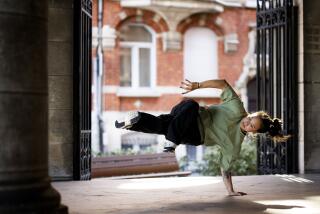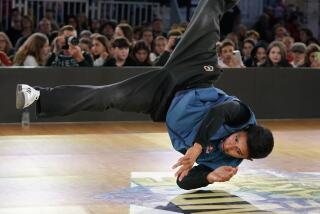Thoughts of Gold in East L.A. : De la Hoya, a Garfield High Senior, Has His Sights Set on the 1992 Olympics at Barcelona After Victory in the Goodwill Games
The scene: Resurrection Gym, on a cool, October afternoon. The tall old man in red suspenders sat on a bench by the ring. He wiped his glasses with his shirt, then watched intently in the dim light as a young boxer sparred before him.
Dozens of young boxers were working out, but the old man looked only at the graceful, smoothly moving teen-ager in the ring.
Throughout the gym, eager, fast fists on a half-dozen speed bags created a roar that could be heard across the street, through the open door. The tat-tat-tat-tat of jump ropes added to the din.
The 17-year-old in the ring was Oscar de la Hoya. He’s the latest in a decades-long line of boxing phenoms to emerge in the gyms of East Los Angeles.
And on this afternoon, in the little gym on Lorena Street that was once a church, the old man on the bench, Ray Saldivar, spoke reverently of De la Hoya.
“Since the 1940s, I’ve seen every great fighter in East L.A., from Manuel Renteria and Cisco Andrade to now, and I saw them all when they were kids . . . and this kid right here is better at this age than any of them,” said Saldivar, a 70-year-old retired machinist and boxing trainer.
A lean, willowy Garfield High senior, De la Hoya won a gold medal at the Goodwill Games last summer and intends to do the same at the 1992 Olympics. Some U.S. amateur boxing officials think that he is America’s most polished amateur boxer and certainly this country’s best bet for a gold medal in the sport at Barcelona, Spain.
De la Hoya is a 5-foot-11 lightweight (132-pound limit) now, but it is expected that he will be a light-welterweight (139) or even a welterweight (147) by the summer of ’92. And nearly everyone in the East L.A. boxing community agrees that he is something special.
During this sparring session, De la Hoya faced a young, relatively inexperienced pro who started aggressively, but by the end of the round had been hit so regularly that he was dancing at long range, avoiding contact.
In the second and last round with this sparmate, De la Hoya worked easily, moving gracefully about the ring, flicking out left jabs at his overmatched partner. Exceptionally long-legged, De la Hoya uses his high center of gravity to great advantage, setting up in a squared-off stance from which he can deliver a left jab or a straight right hand with virtually the same motion.
His stance reminds some of former champions Carlos Monzon and Alexis Arguello.
De la Hoya’s next sparmate was the reason many had gathered at Resurrection Gym on this day. He was to spar two rounds with an accomplished boxer, Ulysses Chong of Phoenix, a welterweight with a 22-2 professional record who weighed 145 pounds. De la Hoya weighed 130.
Their trainers tightened up their fighters’ headgear, and the bell rang.
There were about 50 boxers and trainers in the gym, in various stages of their workouts, and at the bell, everyone stopped. The gym grew quiet. This was special, this commanded everyone’s attention.
“Look, Oscar’s in there with a good pro,” someone whispered.
Chong was much quicker and stronger than the previous partner and he fought aggressively, taking much of the smoothness off De la Hoya’s game. But the latter quickly found his range with his snapping jab, creating opportunities. A minute into the round, when Chong missed a right-hand punch, De la Hoya landed a quick, hard left hook to Chong’s ribs.
After that, Chong’s right hands were delivered with a good deal more caution. The two engaged in brisk, spirited exchanges and fought more or less evenly for two rounds.
De la Hoya is two years away from turning pro; the older, stronger, bigger Chong fights at the Forum for one of pro boxing’s regional championships and a $3,500 payday. As De la Hoya’s trainer, Al Stankie, unlaced his boxer’s headgear, he laughed.
“You know what? If Oscar turns pro tomorrow, he flat-out beats that guy in his pro debut,” Stankie said. “Did you see that hook to the body? He drilled another pro like that at the 108th and Broadway gym last month and decked him.”
Stankie was a vice cop with the Los Angeles Police Dept. for 20 years and a one-time pro light-heavyweight himself. He took Paul Gonzales off the streets of East L.A. and coached him to a gold medal in the 1984 Olympics.
Like a lot of others in East L.A., Stankie has to fasten his seat belt when he starts talking about De la Hoya’s future.
“This kid has more tools, more natural ability than anyone I ever saw,” he said. “He’s the kind of kid who . . . there just isn’t any limit to his future, he can be as good as anyone ever was . . .
“This is normally Oscar’s home gym, but when I want him to spar with some tough pros, I take him to 108th and Broadway, it’s the busiest gym in Southern California. One time, Oscar knocked out two guys there, I mean he put ‘em in Dumboville.
“The first guy he put away was with that left hook to the body and a short right on the chin. The place got dead quiet. I’ll never forget it.”
On the bench, located not far from where there used to be a pulpit, Ray Saldivar said he had seen something special in the De la Hoya-Chong session. “Look at his fundamentals!” Saldivar said. “He’s doing things naturally most kids have to be taught. He’s a born talent. A lot of great fighters are created in gyms, but Oscar . . . you could see the ability when he was a little kid.”
Joel de la Hoya, Oscar’s father, began bringing him by the Resurrection Gym when he was 10. From the beginning, some saw the spark of something special.
“You could see that desire, even then,” said Stankie, who was involved with Gonzales at the time. “He caught your eye with that desire, the way he went after people.”
While Stankie directs Oscar de la Hoya’s workouts, the boxer’s father looks on quietly.
“Oscar’s a very good boy, he doesn’t smoke, drink, fool around--he’s very dedicated to boxing and his schoolwork,” said Joel de la Hoya, 50, who is a dispatcher for an air-conditioning firm in Azusa.
When asked if he would be able to see his son box in Barcelona in 1992--assuming Oscar makes the Olympic team--he put his hands together in a prayerful position, looked skyward, and smiled wistfully.
“It is so expensive, I don’t know,” he said. “Right now, we are looking for a sponsor to help with some of the expenses with Oscar’s amateur career.”
Oscar is a third-generation boxer. Grandfather Vicente, now 74 and living in Mexicali, Mexico, was a 1940s amateur featherweight in Durango, Mexico. And Joel was 13-3 as a pro lightweight in Durango in the mid-1960s.
Vicente de la Hoya came to Los Angeles with part of his family in 1956 and became a mechanic at a garage at Seventh Street and Central Avenue in downtown L.A. Joel arrived the next year.
Now, grandson Oscar is in a countdown to the Olympics.
Next on Oscar de la Hoya’s calendar are the U.S. Amateur Championships at Colorado Springs, Colo., in February, which will also serve as the selection tournament for next summer’s U.S. Pan American Games team.
De la Hoya, who hasn’t lost an amateur bout since he was 14, is the current national featherweight champion, the national Golden Gloves champion, the Goodwill Games champion, the U.S. Olympic Cup champion and, before he turned 16, a two-time Junior Olympic champion.
His toughest critic is his father, he said.
“My dad is pretty excited over what I’ve done so far, but he never shows it much,” De la Hoya said. “He didn’t like my conditioning at the Goodwill Games last summer. I trained hard, but I got tired late in the bouts. I had to explain to him I had a hard time staying at featherweight (125 pounds), that I had to get in the sauna to make weight during the tournament. That’s why I’ve moved up to the 132s.”
At his present age and level of development, one longtime U.S. amateur coach likens De la Hoya to Meldrick Taylor, who won the 1984 Olympic featherweight gold medal at 17.
“And I’d even say Oscar is a little further along at 17 than Meldrick was,” said Roosevelt Sanders, coach of the 1987 U.S. Pan American Games team and now boxing coach of the Camp Lejeune Marines. “He’s different, in a lot of ways. He’s a hard puncher, yet there’s no windup. He doesn’t telegraph a thing. His punches just explode on his opponents. And how many guys at that age do you see go to the body like he can?
“Oscar convinced me how good he was when he stopped Tony Robinson, who is a very tough guy, in a Las Vegas regional tournament a year ago with one body shot.”
De la Hoya and his father are being advised by New York rock music promoter and boxing manager Shelly Finkel, who became the pro adviser/manager to Mark Breland, Meldrick Taylor and Pernell Whitaker after the 1984 Olympics.
Finkel is insisting, he said, that De la Hoya remain an amateur through the 1992 Games.
“Turning pro now, he would be just another prospect,” Finkel said. “But I told Oscar and his dad that with a gold medal in 1992, he’d be a $200,000-a-night fighter, right from his first pro fight.”
Saldivar envisions the skinny De la Hoya growing into a middleweight.
“He’s a tall kid now and maybe he’ll grow even taller,” Saldivar said, watching De la Hoya work on a speed bag. “I think when he’s a mature man, as a pro, say 23 or 24, he’ll be a middleweight.”
Saldivar went down his “East L.A. Boxing Hall of Fame” list from memory, commenting about those who came before Oscar.
“Art Frias came right out of this gym,” Saldivar said. “Not a great boxer, not a great talent, but oh, what a tough slugger he was. . . . Carlos Palomino used to work here sometimes. He was very polished, technically very good. . . . Cisco Andrade was a spectacular young talent who didn’t develop like I thought he should have.
“Art Aragon was a braggart and he had a bad attitude, but he had that great punch. He could really hit. . . . Freddy Babe Herman was another guy I used to love to watch, and Manuel Renteria, too. . . . Joey Olivos came out of this gym, too.”
Saldivar again turned his attention to De la Hoya, now winding up his workout with a jump rope.
“But this kid here, it’s hard to imagine a kid that young doing the things he can do,” he said. “At this age, he’s the best I ever saw.”
More to Read
Go beyond the scoreboard
Get the latest on L.A.'s teams in the daily Sports Report newsletter.
You may occasionally receive promotional content from the Los Angeles Times.










